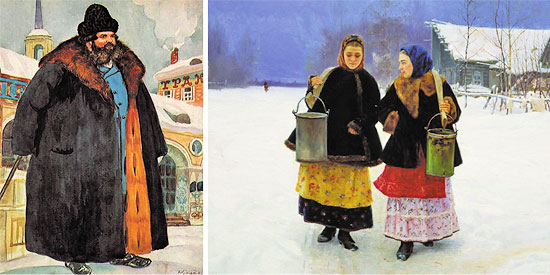FUR COATS
Due to severe climatic conditions in the northern Russia fur coats were widely spread in almost every province and worn by all estates; however, in different areas fashions varied. In the old days men and women wore fur coats with "fur inside", from the outside the coats were either covered with bright fabrics or worn "uncovered".
In Nizhniy Novgorod, Penza, Simbirsk and Smolensk provinces "uncovered" fur coats were made of white raw hide sheepskins, while in Yaroslavl, Vladimir, Moscow and a number of other provinces were sewn from red and black tanned sheepskins. "Covered" female fur coats, characteristic of the Arkhangelsk province, differed by cut and fashion from fur coats that were popular in Cossack villages around the river Don. The Arkhangelsk fur coats were single-breasted, with a ruffled back, cut under shoulder blades, with wrist-long sleeves, decorated at the shoulders with fine pleats. They closed on a single buckle to which a magnificent long bow was attached. The Don fur-coats were whole-cut, wide wrap-around affaires, with sleeves so long that they completely covered the wrist.
The Russians considered fur coats the most elegant winter wear as they permitted the owners to show off various types of expensive fur. The abundance of furs in a household was a sign of prosperity. Russian boyars and noblemen used fur coats not only during frosty days, but at all gala occasions; they even put on fur coats in summertime, or while receiving visitors indoors to show off their wealth. Poor Russian people wore sheepskin coats, or coats made of hare fur. Wolf or bear fur was also inexpensive. People of average wealth preferred squirrel, lynx or leopard. The most expensive furs were fox of all types, beaver, marten and sable. Imperial fur coats were made of ermine.
There were several types of fur coats and the most popular among them were Russian coats and Tursky coats.
The Tursky fur coat was considered an extremely smart outwear. It was usually worn thrown over the shoulders. It was very long, with rather short and wide sleeves.
The Russian fur coat was heavy, floor-long, straight, bell-bottomed – up to 3.5 m in the hem. The front parts of the long sleeves had slots at the elbows, the wide turn-down collar and cuffs were decorated by fur. Fur coats were sewn "fur inside", the fur always served as a lining. Sometimes fur coats were decorated ("covered") with fabric (broadcloth, atlas, brocade, or velvet), but often they were worn "uncovered". At the front a fur coat was fastened by cords, clasps, buttons, or wooden pegs with loops. The long sleeves often went down almost to the floor and sometimes had slots in the front for putting arms through while the sleeves hanged freely down.
There were glamorous (gala) fur coats (covered with bright silk, mainly of turquoise or crimson color) and more practical ones used in open sledges for warmth in wintertime.
The former were used for visits to church, or to receive visitors at home, the latter were an ideal travel wear. Noble women liked to wear a female version of fur coats, distinguished by long and folding "false" or decorative sleeves. If hands were passed through special slots made under the sleeves, the sleeves were gathered in crosscut ruffles. A round fur collar was fastened to the fur coat.

